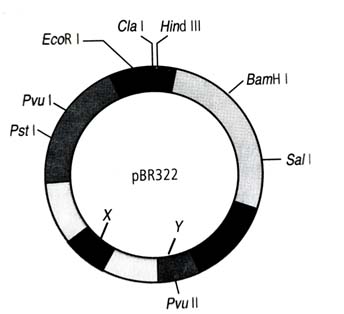Topic Question Set
Q 1
:
The following diagram showing restriction sites in E. coli cloning vector or pBR322. Find the role of 'X' and 'Y' genes. [2024]


The gene ‘X’ is responsible for resistance to antibiotics and ‘Y’ for protein involved in the replication of Plasmid.
The gene ‘Y’ is responsible for controlling the copy number of the linked DNA and ‘Y’ for protein involved in the replication of Plasmid.
The gene ‘X’ is for protein involved in replication of Plasmid and ‘Y’ for resistance to antibiotics.
Gene ‘X’ is responsible for recognition sites and ‘Y’ is responsible for antibiotic resistance.
(2)
In the given diagram showing restriction sites in E.coli cloning vector pBR322, X and Y represent ori and rop, respectively. The gene ‘X’ is responsible for controlling the copy number of the linked DNA and ‘Y’ for protein involved in the replication of plasmid.
Q 2
:
The “Ti plasmid” of Agrobacterium tumefaciens stands for [2024]
tumor inhibiting plasmid
tumor independent plasmid
tumor inducing plasmid
temperature independent plasmid
(3)
‘Ti plasmid’ of Agrobacterium tumefaciens stands for tumour inducing plasmid. The tumour inducing (Ti) plasmid of Agrobacterium tumefaciens has been modified into cloning vector which is not pathogenic to the plants, however, it is still able to use its mechanisms to deliver genes of our interest into various plants.
Q 3
:
Hind II always cuts DNA molecules at a particular point called recognition sequence and it consists of [2024]
8 bp
6 bp
4 bp
10 bp
(2)
Hind II was the first discovered restriction endonuclease enzyme. It was isolated from bacterium Haemophilus influenzae Rd. It cuts DNA molecules at a particular point by recognising a specific sequence of six base pairs. This specific sequence is known as the recognition sequence for Hind II. It produces blunt ends.

Q 4
:
Ligation of foreign DNA at which of the following site will result in loss of tetracycline resistance of pBR322? [2023]
Pst I
Pvu I
EcoR I
BamH I
(4)
In the plasmid vectors, pBR322, tetracycline resistance gene contains recognition sites for two restriction enzymes BamH I and Sal I. The recombinant plasmids will lose tetracycline resistance due to insertion of foreign DNA at one of these sites.
Q 5
:
Which of the following statements is incorrect about Agrobacterium tumefaciens? [2023]
It is used to deliver gene of interest in both prokaryotic as well as eukaryotic host cells.
‘Ti’ plasmid from Agrobacterium tumefaciens used for gene transfer is not pathogenic to plant cell.
It transforms normal plant cells into tumor cells.
It delivers ‘T-DNA’ into plant cell.
(1)
Ti plasmid (tumour inducing) from the soil bacterium Agrobacterium tumefaciens is effectively used as vector for gene transfer to eukaryotic (plant) cells. The part of Ti plasmid transferred into plant cell DNA is called the T-DNA.
Q 6
:
Match List I with List II. [2023]
List I
List II
(A)
Kanamycin
(I)
Delivers genes into animal cells
(B)
Cla I
(II)
Selectable marker
(C)
Disarmed retroviruses
(III)
Restriction site
(D)
gene
(IV)
Antibiotic resistance
Choose the correct answer from the options given below:
(A)-(II), (B)-(III), (C)-(I), (D)-(IV)
(A)-(III), (B)-(I), (C)-(IV), (D)-(II)
(A)-(IV), (B)-(III), (C)-(I), (D)-(II)
(A)-(II), (B)-(IV), (C)-(I), (D)-(III)
(1)
Q 7
:
Upon exposure to UV radiation, DNA stained with ethidium bromide will show [2023]
bright yellow colour
bright orange colour
bright red colour
bright blue colour
(2)
The DNA fragments separated by gel electrophoresis can be visualised after staining the DNA with ethidium bromide followed by exposure to UV radiations. Bands of DNA are seen as bright orange coloured bands in ethidium bromide stained gel exposed to UV light.
Q 8
:
In gene gun method used to introduce alien DNA into host cells, microparticles of ________ metal are used. [2023]
tungsten or gold
silver
copper
zinc
(1)
In biolistics or gene gun method, cells are bombarded with high velocity micro-particles of gold or tungsten coated with DNA.
Q 9
:
Which of the following is not a cloning vector? [2023]
pBR322
Probe
BAC
YAC
(2)
Cloning vectors are DNA molecules into which foreign DNA can be introduced and transmitted to host cell for use in cloning. Different types of cloning vectors are plasmids, bacteriophages, BAC, YAC. A probe is single stranded sequence of DNA or RNA used to identify complementary sequence in genome.
Q 10
:
Which one of the following statements is not true regarding gel electrophoresis technique? [2022]
The process of extraction of separated DNA strands from gel is called elution.
The separated DNA fragments are stained by using ethidium bromide.
The presence of chromogenic substrate gives blue coloured DNA bands on the gel.
Bright orange coloured bands of DNA can be observed in the gel when exposed to UV light.
(3)
In gel electrophoresis, the DNA fragments separate according to their size through the agarose gel, with smaller fragments moving farther away as compared to larger ones. The orange coloured bands of DNA can be visualised by staining them with ethidium bromide followed by exposure to UV radiations. The separated bands of DNA are cut out from the agarose gel is called elution.

